人教版高中英语选修八 Unit 5 Meeting your ancestors Reading 课件共32张PPT)
文档属性
| 名称 | 人教版高中英语选修八 Unit 5 Meeting your ancestors Reading 课件共32张PPT) |  | |
| 格式 | zip | ||
| 文件大小 | 1.1MB | ||
| 资源类型 | 教案 | ||
| 版本资源 | 人教版(新课程标准) | ||
| 科目 | 英语 | ||
| 更新时间 | 2018-12-13 18:11:02 | ||
图片预览


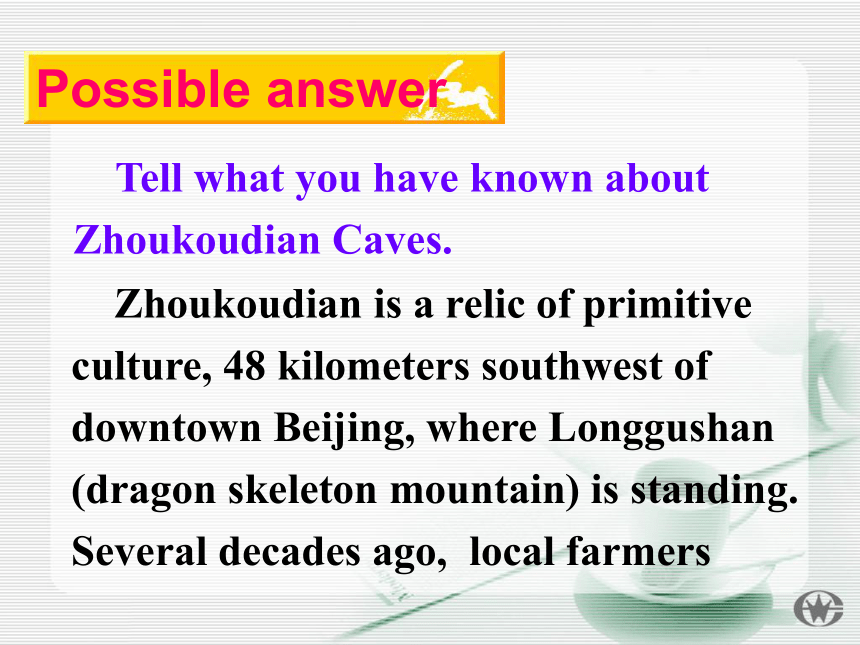
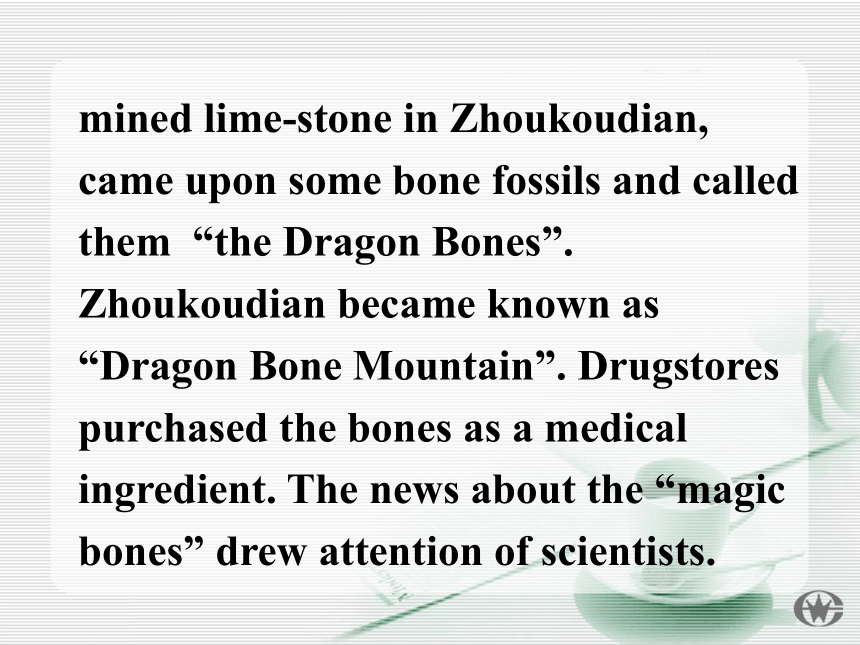

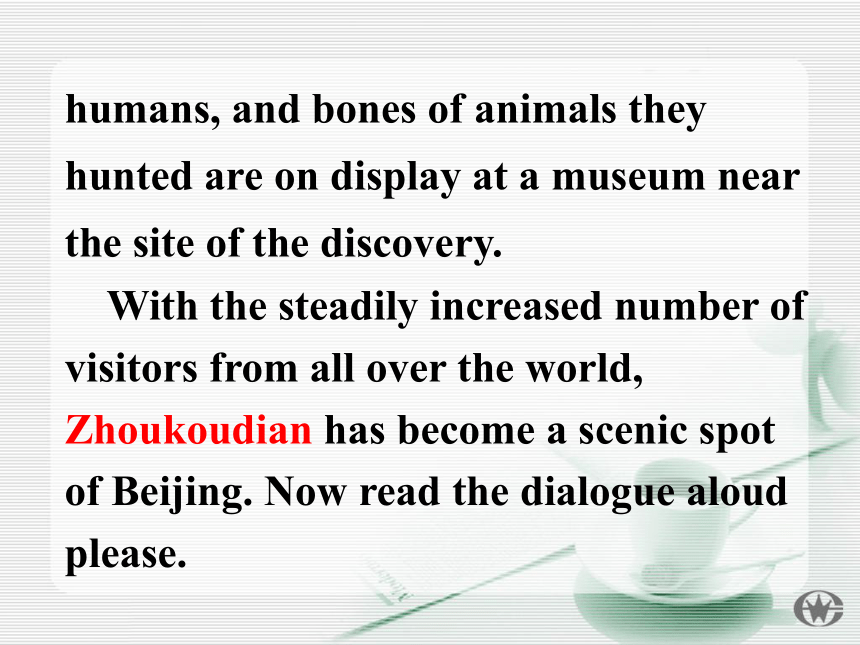
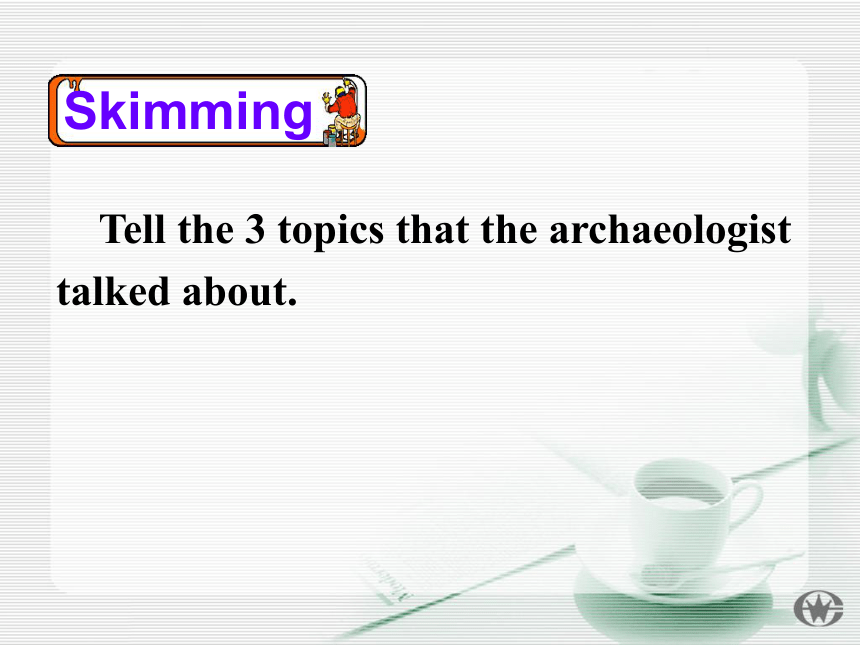
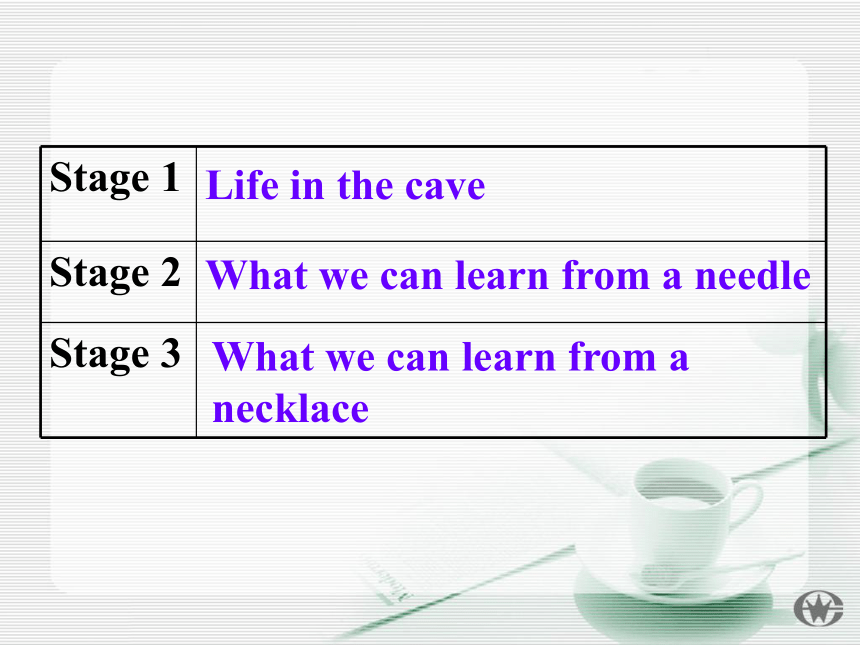

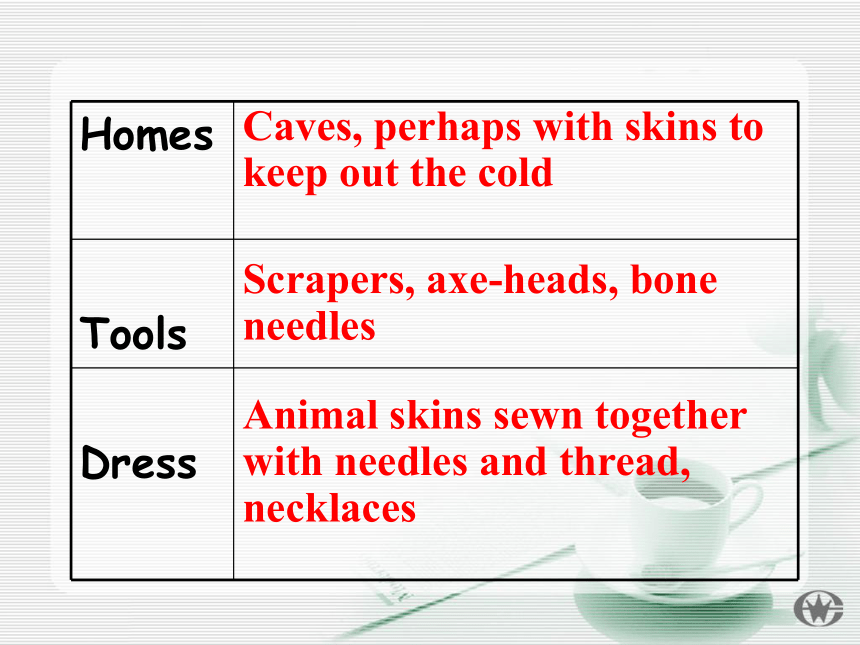
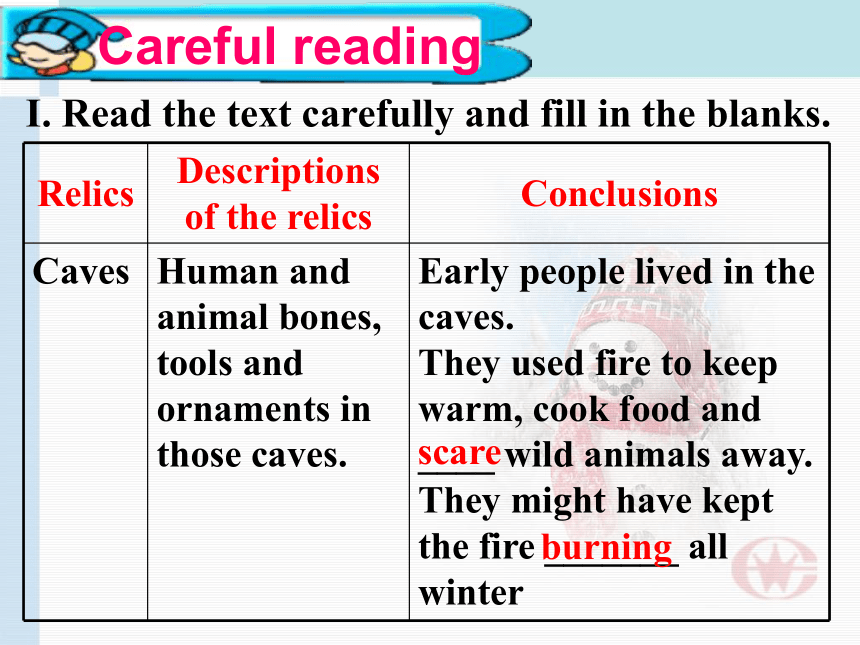
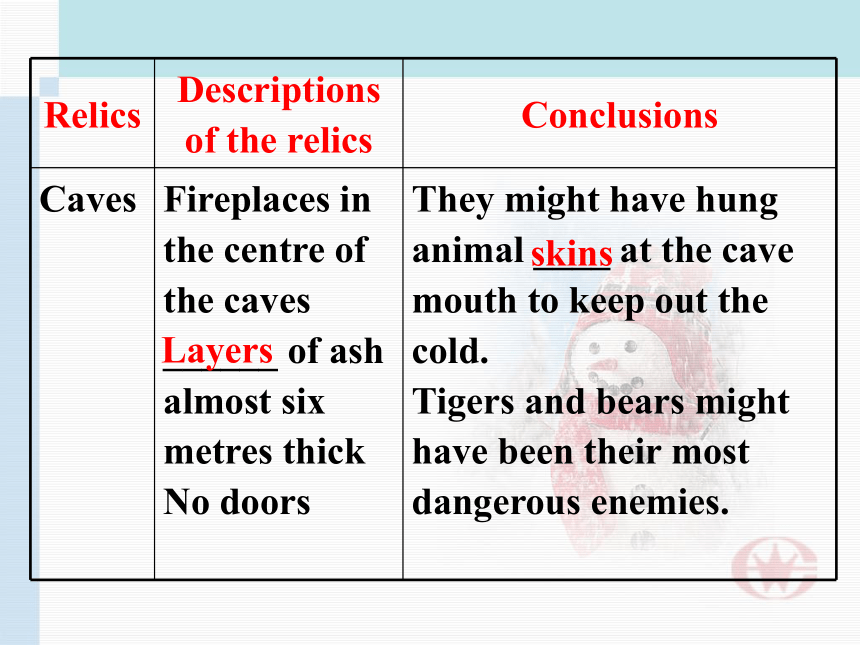
文档简介
课件32张PPT。ReadingWhat is it?Possible answer Zhoukoudian is a relic of primitive culture, 48 kilometers southwest of downtown Beijing, where Longgushan (dragon skeleton mountain) is standing. Several decades ago, local farmers Tell what you have known about Zhoukoudian Caves. mined lime-stone in Zhoukoudian, came upon some bone fossils and called them “the Dragon Bones”. Zhoukoudian became known as “Dragon Bone Mountain”. Drugstores purchased the bones as a medical ingredient. The news about the “magic bones” drew attention of scientists. In 1929 these lime-stone caves became world famous with the discovery of a skull and two teeth dating back 200,000 to 500,000 years. They were named Peking Man. But the fossils were lost during World War II. Many of the implements used by those early humans, and bones of animals they hunted are on display at a museum near the site of the discovery.
With the steadily increased number of visitors from all over the world, Zhoukoudian has become a scenic spot of Beijing. Now read the dialogue aloud please. Tell the 3 topics that the archaeologist talked about.SkimmingLife in the caveWhat we can learn from a needleWhat we can learn from a necklace Read the text again and get the main idea of the dialogue and then write down the three ways in which the life of early people differs from modern ones.ScanningCaves, perhaps with skins to keep out the coldScrapers, axe-heads, bone needlesAnimal skins sewn together with needles and thread, necklacesscareburningCareful readingI. Read the text carefully and fill in the blanks.Layersskinsboneclothestradeseaside 1. Why have the English students come to the Zhoukoudian caves?
The students want to find out about how early people lived. There are no such sites in England while the Zhoukoudian caves provide an excellent example of a site where early people lived. II. Answer the following questions after a careful reading. 3. How did they keep warm?
They constructed the fires in the center of the caves to keep them warm. They might have kept fires burning all winter. They hung animal skins at the cave mouth to keep out the cold. 2. Where did early people live?
Early people lived in caves.4. What did they use for doors?
The archaeologist thinks they may have used animal skins.5. What did they eat?
They ate animal meat, such as tigers and bears, and fish from the lake nearby. They also picked fruit when it was ripe.6. What animals were their most dangerous enemies?
Tigers and bears were their most dangerous enemies. Their clothes were made from animal skins. They used sharpened stone tools to cut up the animals and remove their skin. Then smaller scrapers were used to clean the fat and meat from them. They had to rub an ample amount of salt inside the skin to make it soft enough. Finally, they would have cut it and sewn the pieces together with needles made of animal bones.7. How did they make clothes? Some of the necklace beads were made of animal bones but some were made of shells, which tell us that all the fields around here used to be part of a large shallow lake. Perhaps there was trade between early people or they traveled to the seaside on their journeys.8. What can we learn from the necklace they wore?9. What did the earliest people use fire for?
They used fire to keep them warm, cook the food and scare the animals.
10. What’s the main idea of the text?
A brief introduction of the life and habits of the earliest people in Zhoukoudian.III. Read the text carefully and choose the best answer.1. Where do the caves lie?
A. In the forest.
B. On the seaside.
C. At the foot of the hill. D. Higher up the hill.2. Which of the following is the correct order about how early people made clothes?
a. clean the fat and meat from the skin
b. cut up the animals
c. rub salt inside the skin
d. remove the skin
e. sew the pieces together
A. b-d-c-a-e B. b-d-a-c-e
C. b-a-d-c-e D. b-a-c-d-e3. Which of the following shows us the earliest people and the modern people have something in common?
A. People hung animal skins to keep out the cold
B. People never grew their own crops
C. People use science
D. People care about their appearance4. What can we infer from the sentences--- “This one looks very like a fish bone. Is it reasonable? ---Yes indeed, as the botanical analyses have shown us, all the fields around here used to be part of a large shallow lake. Probably there were fish in it.”?
A. Being an archaeologist needs a wide range of knowledge.
B. A lake is not the sea.
C. People can identify the fish by the colour.
D. A fish bone can be made into a necklace.Stone, wooden or brick house. CaveVery accurate Compare modern people and Peking man, and finish the following form.Wooden, special for each roomfireplace AccurateTV, sport, films, hobbies, education, job Meals together InaccurateFruit, vegetables, meat and fish, etc. Meat, fish, berries and fruit in season AccurateNatural and man-made fibres. skins, leaves Accurate Do you think it is important for us to know about them? Why?
Zhoukoudian Caves were formally inscribed (记入) on the “World Heritage List” in December 1987 at the eleventh session of UNESCO World Heritage Committee. The inscriptionSummary of the Peking Man Site on the World Heritage List confirms the exceptional and universal value of the cultural site, which requires protection for the benefit of all humanity. The site is therefore not only of China, but also of the world as a whole. 1) Go over the text.
2) Write a brief introduction to the Zhoukoudian Caves.
3) Preview “the present perfect continuous tense”.Homework
With the steadily increased number of visitors from all over the world, Zhoukoudian has become a scenic spot of Beijing. Now read the dialogue aloud please. Tell the 3 topics that the archaeologist talked about.SkimmingLife in the caveWhat we can learn from a needleWhat we can learn from a necklace Read the text again and get the main idea of the dialogue and then write down the three ways in which the life of early people differs from modern ones.ScanningCaves, perhaps with skins to keep out the coldScrapers, axe-heads, bone needlesAnimal skins sewn together with needles and thread, necklacesscareburningCareful readingI. Read the text carefully and fill in the blanks.Layersskinsboneclothestradeseaside 1. Why have the English students come to the Zhoukoudian caves?
The students want to find out about how early people lived. There are no such sites in England while the Zhoukoudian caves provide an excellent example of a site where early people lived. II. Answer the following questions after a careful reading. 3. How did they keep warm?
They constructed the fires in the center of the caves to keep them warm. They might have kept fires burning all winter. They hung animal skins at the cave mouth to keep out the cold. 2. Where did early people live?
Early people lived in caves.4. What did they use for doors?
The archaeologist thinks they may have used animal skins.5. What did they eat?
They ate animal meat, such as tigers and bears, and fish from the lake nearby. They also picked fruit when it was ripe.6. What animals were their most dangerous enemies?
Tigers and bears were their most dangerous enemies. Their clothes were made from animal skins. They used sharpened stone tools to cut up the animals and remove their skin. Then smaller scrapers were used to clean the fat and meat from them. They had to rub an ample amount of salt inside the skin to make it soft enough. Finally, they would have cut it and sewn the pieces together with needles made of animal bones.7. How did they make clothes? Some of the necklace beads were made of animal bones but some were made of shells, which tell us that all the fields around here used to be part of a large shallow lake. Perhaps there was trade between early people or they traveled to the seaside on their journeys.8. What can we learn from the necklace they wore?9. What did the earliest people use fire for?
They used fire to keep them warm, cook the food and scare the animals.
10. What’s the main idea of the text?
A brief introduction of the life and habits of the earliest people in Zhoukoudian.III. Read the text carefully and choose the best answer.1. Where do the caves lie?
A. In the forest.
B. On the seaside.
C. At the foot of the hill. D. Higher up the hill.2. Which of the following is the correct order about how early people made clothes?
a. clean the fat and meat from the skin
b. cut up the animals
c. rub salt inside the skin
d. remove the skin
e. sew the pieces together
A. b-d-c-a-e B. b-d-a-c-e
C. b-a-d-c-e D. b-a-c-d-e3. Which of the following shows us the earliest people and the modern people have something in common?
A. People hung animal skins to keep out the cold
B. People never grew their own crops
C. People use science
D. People care about their appearance4. What can we infer from the sentences--- “This one looks very like a fish bone. Is it reasonable? ---Yes indeed, as the botanical analyses have shown us, all the fields around here used to be part of a large shallow lake. Probably there were fish in it.”?
A. Being an archaeologist needs a wide range of knowledge.
B. A lake is not the sea.
C. People can identify the fish by the colour.
D. A fish bone can be made into a necklace.Stone, wooden or brick house. CaveVery accurate Compare modern people and Peking man, and finish the following form.Wooden, special for each roomfireplace AccurateTV, sport, films, hobbies, education, job Meals together InaccurateFruit, vegetables, meat and fish, etc. Meat, fish, berries and fruit in season AccurateNatural and man-made fibres. skins, leaves Accurate Do you think it is important for us to know about them? Why?
Zhoukoudian Caves were formally inscribed (记入) on the “World Heritage List” in December 1987 at the eleventh session of UNESCO World Heritage Committee. The inscriptionSummary of the Peking Man Site on the World Heritage List confirms the exceptional and universal value of the cultural site, which requires protection for the benefit of all humanity. The site is therefore not only of China, but also of the world as a whole. 1) Go over the text.
2) Write a brief introduction to the Zhoukoudian Caves.
3) Preview “the present perfect continuous tense”.Homework
